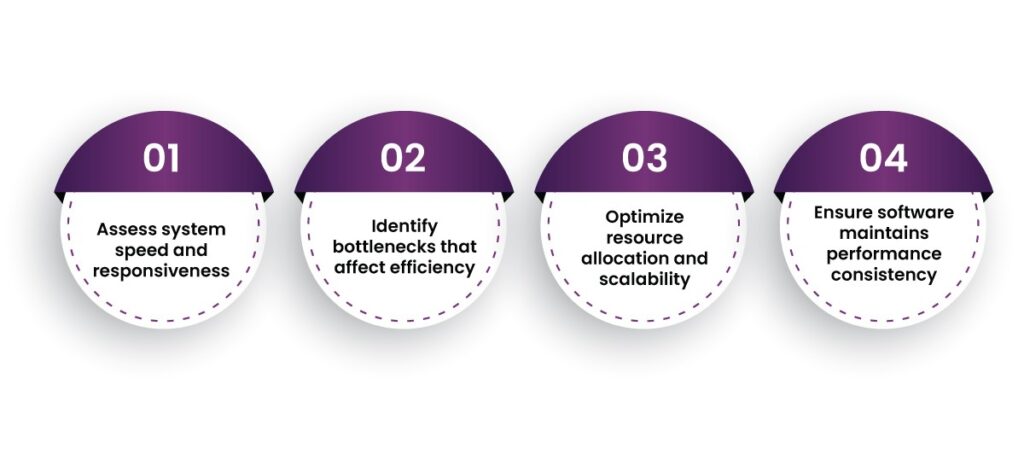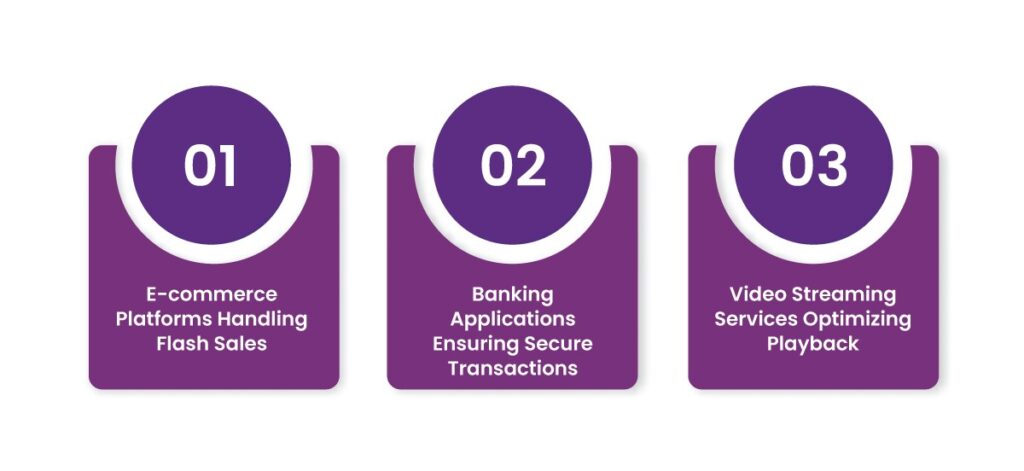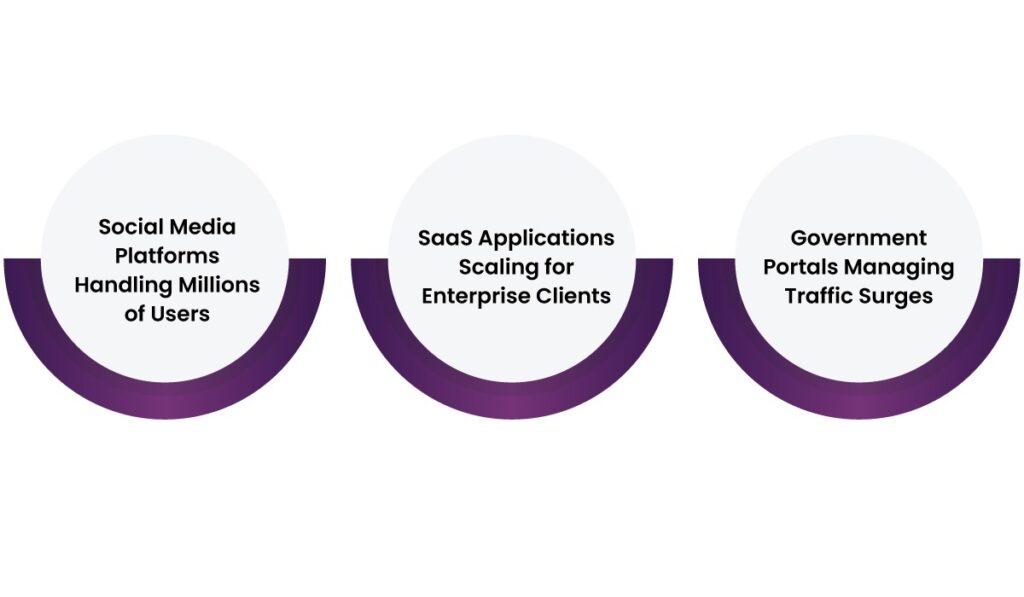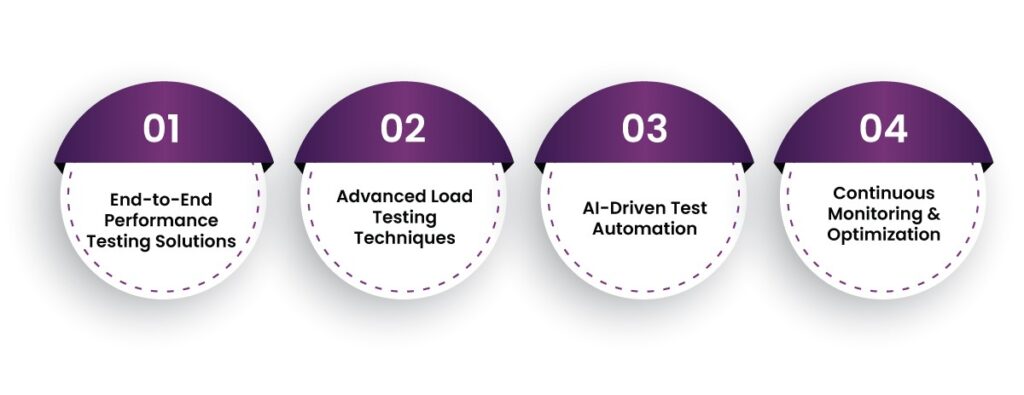What happens when an application crashes under heavy traffic or slows down when multiple users access it? Performance issues can result in lost revenue, frustrated users, and reputational damage. This is where performance testing and load testing become essential. Although these terms are often used interchangeably, they serve distinct purposes in software quality assurance.
Understanding the differences between performance testing and load testing is crucial for businesses aiming to optimize software efficiency. In this guide, we’ll explore their differences, when to use each, and how Helixbeat’s advanced QA solutions help businesses maintain high-performing, reliable software.
Table of Contents
What is Performance Testing?
Performance testing evaluates how well a system operates under expected and varying conditions. It measures crucial aspects such as response time, resource utilization, scalability, and overall system stability. By simulating real-world scenarios, this testing ensures that applications meet the required speed, responsiveness, and reliability standards before they are deployed.
Goals of Performance Testing:
- Assess system speed and responsiveness – Determines how quickly an application processes user requests and responds under different workloads.
- Identify bottlenecks that affect efficiency – Detects issues like slow database queries, unoptimized code, or network latency that could impact user experience.
- Optimize resource allocation and scalability – Ensures that CPU, memory, and bandwidth are effectively utilized to handle increasing demands.
- Ensure software maintains performance consistency – Verifies that the system remains stable and performs reliably under peak and sustained loads.

By conducting thorough performance testing, businesses can prevent downtime, improve user satisfaction, and enhance software efficiency before it reaches end users.
What is Load Testing?
Load testing is a specialized type of performance testing that evaluates how software performs under a specified workload. It determines whether an application can handle multiple concurrent users, transactions, or system requests without experiencing slowdowns, crashes, or failures. By simulating real-world user activity, load testing helps businesses assess system reliability and stability before deployment.
Goals of Load Testing:
- Identify the system’s operating capacity under normal and peak conditions – Measures how well an application functions during typical usage and stress scenarios to determine its maximum performance threshold.
- Detect performance degradation when the system is under heavy demand – Uncovers slow response times, memory leaks, or server overload issues that may arise when multiple users interact with the software simultaneously.
- Ensure software scalability and responsiveness – Verifies that the system can efficiently scale as user demand increases while maintaining optimal speed and functionality.

By conducting load testing, businesses can optimize software performance, prevent downtime, and create a seamless user experience, even under high traffic conditions.
Differences Between Performance Testing and Load Testing
Differentiating between performance testing and load testing is crucial for businesses striving to enhance software efficiency. While both approaches assess system reliability, each plays a unique role in ensuring optimal functionality under varying conditions.
| Aspect | Performance Testing | Load Testing |
| Purpose | Measures overall software speed, stability, and responsiveness. | Assesses how software behaves under a specific workload. |
| Scope | Involves stress testing, scalability testing, and endurance testing to evaluate system performance in different scenarios. | Focuses solely on real-world user loads and their impact on system behavior. |
| Bottlenecks Identified | Detects system-wide inefficiencies, slow response times, memory leaks, and resource utilization issues. | Uncovers performance degradation caused by concurrent user loads, ensuring system stability under demand. |
| Use Case | Ensures a smooth user experience across various conditions, including peak and non-peak usage. | Determines system stability under high traffic conditions, preventing crashes and slowdowns. |
By integrating both performance testing and load testing into the software development cycle, businesses can ensure that applications are not only stable under regular conditions but also resilient when demand spikes.
Use Cases of Performance Testing
Performance testing plays a crucial role in ensuring software applications run smoothly under various conditions, helping businesses maintain reliability, efficiency, and a seamless user experience. Here are a few use cases where performance testing plays a critical role.
1. E-commerce Platforms Handling Flash Sales
Online retailers experience sudden traffic spikes during major sales events like Black Friday and Cyber Monday. Performance testing helps optimize server response times, ensuring websites do not crash under heavy demand. By simulating thousands of concurrent users, businesses can identify weak points in their infrastructure and implement load-balancing strategies to prevent downtime.
2. Banking Applications Ensuring Secure Transactions
Financial institutions process thousands of transactions per minute, making system stability critical. Performance testing ensures that banking applications can handle high volumes of simultaneous transactions without delays or errors. It also helps identify potential slowdowns in payment processing, enabling banks to maintain a seamless and secure digital banking experience for their customers.
3. Video Streaming Services Optimizing Playback
Streaming platforms like Netflix, YouTube, and Disney+ rely on performance testing to deliver uninterrupted video playback, even during high-traffic hours. By testing bandwidth efficiency, buffering times, and server load capacity, performance testing ensures that users experience smooth streaming without lags, irrespective of their location or device.

Use Cases of Load Testing
Load testing is essential for applications that experience fluctuating traffic, ensuring they can handle high user volumes without performance degradation. Here are a few use cases where load testing plays a critical role.
1. Social Media Platforms Handling Millions of Users
Social networking sites like Facebook, Twitter, and Instagram manage millions of users logging in, posting updates, and streaming live videos simultaneously. Load testing helps these platforms assess server capacity, prevent crashes, and maintain smooth functionality even during viral events or global trends that spike user activity.
2. SaaS Applications Scaling for Enterprise Clients
Cloud-based SaaS applications cater to businesses of all sizes, from startups to large enterprises. Load testing ensures these platforms can efficiently scale to accommodate growing user bases, multiple concurrent sessions, and heavy database interactions. This helps SaaS providers deliver a seamless experience without slowdowns or outages.
3. Government Portals Managing Traffic Surges
Public service websites, such as tax filing portals and election registration systems, experience massive traffic spikes during specific periods. Load testing ensures that these platforms remain responsive and stable under heavy demand, preventing downtime and enabling citizens to access services without disruptions.

Why Performance and Load Testing Are Essential for Business Success?
Ignoring performance and load testing can lead to severe consequences:
- Revenue Loss: A slow website can cause customers to abandon purchases.
- Reputation Damage: Negative user experiences impact brand credibility.
- Security Risks: System failures expose vulnerabilities to cyber threats.
By integrating robust performance testing and load testing strategies, businesses can safeguard against these risks and optimize user satisfaction.
How Helixbeat Ensures Optimal Performance & Load Testing?
To deliver high-performing, scalable, and resilient applications, Helixbeat combines advanced testing methodologies with cutting-edge technology. Here’s how Helixbeat optimizes performance and load testing for seamless software functionality.
1. End-to-End Performance Testing Solutions
Helixbeat’s comprehensive QA testing services evaluate application speed, stability, and efficiency using both manual and automated testing approaches. This ensures that software meets performance benchmarks before deployment.
2. Advanced Load Testing Techniques
Simulating high-traffic scenarios allows Helixbeat to test system resilience, identifying potential bottlenecks before they impact real users. By analyzing stress points, businesses can prevent crashes and ensure smooth operations even during peak demand.
3. AI-Driven Test Automation
With AI-powered testing tools, Helixbeat enhances accuracy and accelerates bug detection. Automated test scripts streamline the process, reducing testing time while ensuring consistent software performance.
4. Continuous Monitoring & Optimization
Performance testing doesn’t stop at deployment. Helixbeat provides real-time analytics, continuous monitoring, and proactive performance tuning to help businesses maintain system efficiency and responsiveness at all times.

Final Words
Both performance testing and load testing play critical roles in software quality assurance. While performance testing ensures an application’s overall speed and efficiency, load testing determines its capacity to handle concurrent users. Choosing the right testing strategy depends on your business goals, application type, and expected traffic levels.
Helixbeat provides cutting-edge performance and load testing services tailored to modern businesses. With advanced automation, real-time analytics, and AI-driven test strategies, Helixbeat helps enterprises optimize software performance and scalability.
Ready to strengthen your software performance? Contact Helixbeat today and ensure seamless user experiences for your customers.
FAQs
1. What is the main difference between performance testing and load testing?
Performance testing evaluates an application’s overall speed and stability, while load testing focuses on how the system performs under varying levels of concurrent users.
2. Why is load testing important for SaaS applications?
SaaS applications must handle multiple users simultaneously. Load testing ensures these platforms maintain stability under growing user demand.
3. When should businesses conduct performance testing?
Performance testing should be done regularly, especially before product launches, feature updates, and expected traffic spikes.
4. What tools are commonly used for load testing?
Popular load testing tools include JMeter, LoadRunner, and Gatling, which help simulate real-world traffic scenarios.
5. Can load testing predict system failures?
Yes, load testing identifies performance bottlenecks and potential system failures before they impact real users.
6. How does Helixbeat enhance performance testing strategies?
Helixbeat utilizes AI-driven automation, real-time monitoring, and predictive analytics to optimize software performance.
7. Do startups need load testing?
Yes, startups launching new products must ensure their applications can scale efficiently as user demand increases.














